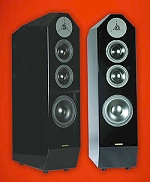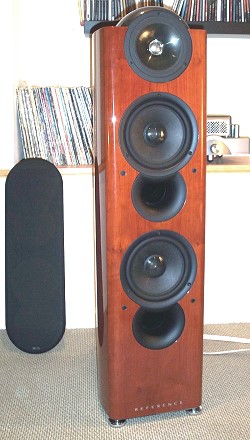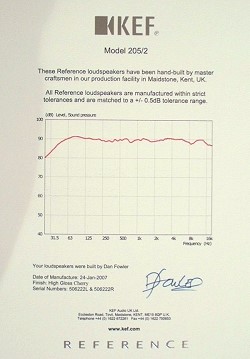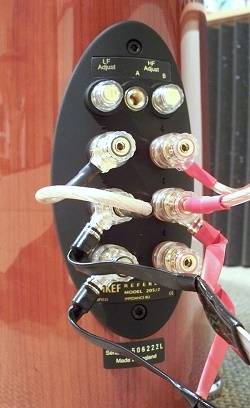Introduction
I’ve been to many audio shows and as you move from room to room, you tend to look around to gauge the others sitting around you to get a sense of whether they hear what you hear, good or bad. Generally, if it’s not very good, most do not stay seated very long, or do not ask many questions as they politely exit. But if it’s good, a nod of the head, a toe-tap, or a broad smile, and nobody wants to give up the sweet spot.
The last KEF audition was the latter listening to their Reference series, and if you ask around as we all do during a show which room impressed you, very often you’d hear the KEF room.
I’ve been a KEF fan for years, so I’ll get that out of the way up front. Frankly, their speakers have always been good to my ears. Models have come and gone, yet for some reason they have repeatedly maintained a level of quality and sound that has always appealed to me.
Shortly after reviewing the KEF Q-Series complete home theater package (of which I purchased the review units), I was anxious to move onto review a pair for my two-channel system. KEF had just released the media information on the new Reference line and I wanted in.
Their latest release in the Reference line smartly includes not only full floor-standing models but a monitor, two each center channels, surrounds, and subwoofers.
The prize in my mind however are the floorstanding units beginning with the flagship Model 207/2, and while I asked to review the 205/2 units, there is yet one below, the 203/2. The “2” represents a revision to previous versions.
Specifications
- Design: Three-Way; Ported
- Drivers: One 1″ Dome Tweeter, One 6.5″ Midrange, Two 8″ Woofers
- MFR: 45 Hz – 60 kHz
- Sensitivity: 90 dB
- Nominal Impedance: 8 Ohms
- Crossover Frequencies: 400 Hz, 2.3 kHz
- Dimensions: 43.5″ H x 11.2″ W x 17″ D
- Weight: 73 Pounds/Each
- MSRP: $12,000/Pair USA; Finished in Cherry, Walnut, Sycamore, Piano Black
So a pair of Reference Model 205/2 arrived on my doorstep. Unpacking the units, I was struck by two things in particular. KEF sends along an incredible wood case containing some beautifully machined accessories. Included are optional carpet spikes or flat bottom pedestals, which I chose specifically to be able to move them around and position them with ease. Also sent along are tools including a wrench to tighten the feet and sturdy jumper cables. There are extra caps for the LF and HF adjustments which I’ll talk about later, and finally a very nice level, which I’ve used setting up a turntable too!
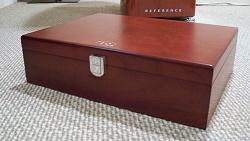
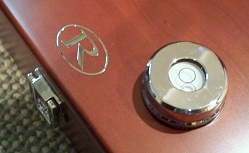
Secondly, the high-gloss cherry wood finish immediately blew me away. That fine traditional British craftsmanship and design are evident in every aspect of the Reference, from the conservative yet elegant shape to fit and finish. The veneer appears seamless and is carefully hand-crafted in a mirror finish.
Along with the handsome manual included was a frequency response chart (on beautiful parchment paper) specific for this pair cordially signed by the builder, Dan Fowler.
As far as I know, the Reference Series is the only product KEF still fabricates in England, as everything else is farmed out to the far-east for production. As good as the quality of the Q-Series, this is another league all together.
Near the end of my review, I asked KEF’s Reference Business Unit Manager Richard Colburn to simply give me his feelings about the 205/2’s:
“The 205s are special to me because they embody all of he hallmarks of classic KEF products (think Reference 104ab, 105, 107 and the 104/2). These products were known for their supreme musicality as well as fine detail. With this new Reference series, we have resurrected this philosophy and updated it. The 205 gets all of the detail right (by right, I mean it knows what to do with that detail which is to present it in a musically accurate manner). A lot of speakers spotlight certain aspects of the music, and the listener tends to focus on that and will either like it or not. The 205 walks that thin line between detail and musicality extremely well. I also like how musical texture comes through on the 205. Fine details emerge as part of a very pleasing picture. Finally, I love how muscular the 205s sound for their fairly modest footprint. You get some of the grandeur of the 207 without floor space being compromised.”
The Design
The KEF Reference Model 205/2 is a three-way bass reflex, stands almost 44″ high and weighs 73 pounds. KEF reports that the frequency response expected from the 205/2 is from 45 Hz to 60 kHz, and the crossover is set at 400 Hz and 2.3 kHz. Also, rated at 8 ohms with a 90 dB sensitivity rating, the 205/2 handles up to 300 watts from your amplifier.
The obvious distinction between the 207/2 and the 205/2 is the additional driver and the distinct separate tweeter enclosure mounted on top. Of course the 207/2 weighs almost twice as much and stands five inches taller.
The shape of the speaker can’t be ignored, as no sharp corners exist, but has gentle curves sweeping from front to rear with even the front edges radiuses about an inch.
Fabric grilles for each speaker are separated for the Uni-Q array and the pair of woofer drivers. Which means you can keep the grille on or off for each type of driver. The manual surprisingly recommends removing the grilles for “serious listening”.
Spinning (not literally) the cabinet around, you’ll discover several features. Uni-Balance is a technology that allows alteration to bass output depending on the placement in the room. The “LF” adjustment is a cap that’s either left in or removed. Leaving it in is best if the speakers are free of the side and rear walls. Removing it will drop the bass output by -2.0 dB between 50 and 150 Hz.
High frequency adjustments use 2 caps and with four positions possible adjusting tweeter output above 2kHz by as much as +75dB or drop as much as -1.5dB.
At the bottom rear you’ll also find gold-plated binding posts for tri-wiring or tri-amping. Sent along are sturdy jumper cables with a banana plug on one end and spade on the other. Use the cables if you decide to run a single pair of speaker wires to the 205/2 and let the internal crossovers handle the delivery to each driver.
Uni-Q
Now used in the diverse KEF line, the heart of the Reference line is the Uni-Q driver array. Specifically called “Project Austin” for the Reference Series, the Uni-Q design means the high frequency and mid drivers share the same axis, in-line or “co-axial” and further aligns their acoustic centers on the same plane thereby “co-planar”.
As mentioned, Uni-Q array has been the staple of most KEF speakers over the years with many modifications and iterations. The premise is the precision between the tweeter and midrange driver acting in unison, delivering high frequency and midrange to your ear in perfect time. This time-alignment is said to deliver more natural and realistic imaging.
The Uni-Q proprietary driver array design arrangement is with a 1″ titanium tweeter centered on a 6 ½” midrange driver where a wider dispersion is also achieved with a shallower cone design.
So much is said about Uni-Q it would be remiss to mention two additional 8″ woofer drivers each individually front ported by a very large opening about 3″ at the throat. By individual, it’s clear that each driver is ideally volumetrically enclosed. Birch plywood does the trick and also provides extensive bracing and damping.
Setup
Placement is a bit forgiving – especially with the wide dispersion from the Uni-Q array, that toeing the speaker yielded very little difference, but I did it anyway, just habit I suppose. The manual recommends placing them about 3 feet from each sidewall and as little as 9 inches from the back wall. Critical for stereo imaging though is the distance between the speakers, as I ended up with about 6 feet between, a minimum really.
For amplification, I used the MA6300 – 100wpc McIntosh integrated which turned out to be a wonderful marriage. Also used were a Marantz turntable and a McCormack UDP-1 universal player. Cables were Wireworld and Goertz, and all plugged into a Torus Power conditioner.
Listening
I was fortunate enough to attend the live recording of Stereophile’s “Attention Screen” at Merkin Hall in Manhattan, and shortly after a CD release was available. Although during the performance I had mixed feelings about whether I liked the concert, I bought the CD nonetheless as it offered a good reference for reviews.
Attention Screen is comprised of four musicians that play spontaneous and un-composed music with a freedom to create differently for each performance – where they begin and where they end is unknown. Piano, drums, guitar, and bass guitar blend and dialogue off and with each other. Each piece is generally quite long lasting from 10 to 13 minutes.
What I did find amazing was the trust amongst the members as each improvised and allowed the others to explore in true abstract fashion. The recording is excellent and each instrument is cleanly defined, articulate, and spatially “correct”.
The KEF 205/2 made easy use of the music – drum lines snapped, the electric guitar was sharp and forward, and the piano pulled it all together just as it occurred during the live performance. A true sense of “liveness” was eloquently evident throughout the six tracks.
Although not quite brutes, the 205/2’s offer such delicate texture and airiness as I experienced with the SACD of Anne-Sophie Mutter’s violin on Beethoven’s Spring & Kreutzer Sonatas. Accompanied by Lambert Orkis on piano, the duet is intimate and rich. Although I put it in specifically for the violin, the piano impressed me with warmth and yet crisp detail.
The midrange challenge came by way of The Beatles Love CD, ironic as it was through the 205/2’s experienced at CES that I heard this rendition for the first time. At the show as it was at home, the first track “Because” was/is immediately engaging – voices are shaped and the stillness between breaths is palpable.
Track 4, “Eleanor Rigby” transitioning to “Julia” and onto “I am the Walrus” is emphasized through the 205/2 with true spaciousness and dimension. Layers of voices deep and far, or close and upfront, are delineated cleanly.
The guitar introduction “Blackbird” is so remarkably rendered on the 205/2, I would have sworn it was being played right next to me! Truly, that sweet and that perfect! I would have enjoyed more than just the fraction they included. Paul’s voice going into “Yesterday” almost makes up for it with simple clarity.
Nirvana for me is detail – scratching my head, I pulled out an XRCD sampler CD, Super Sounds II and played the opening track, Bernstein leading the London Festival Orchestra with the “Magnificent Seven” where the attack and timing are dead on.
An excerpt of Mozart’s “Divertimento in D, K. 136” played by the Academy of St. Martin-in-the Fields with Sir Neville Mariner, is full-bodied with a deep and wide soundstage.
Looking for powerful and extended bass, I played a new CD, Pipes of Rhode Island. This is an eclectic compilation of performances from organists from Rhode Island in various venues. Nowhere else can bass be produced than in a great stone hall that echos through the chambers and engulfs you! The 8″ drivers in the KEF 205/2’s offered such texture and depth that I felt it in my chest.
Conclusions
Bigger is still better, period – at least when it comes to two-channel systems. Believe me I’ve heard many fine sounding monitors (with and without a separate subwoofer) auditioned at shows and in my own listening room. Several reviewed I’ve purchased or wanted to badly, yet like the preverbal big fish I throw them back to wait for the one that’s just too amazing to return.
The 205/2’s delighted me – these are big brooding speakers, and I expected a full bottom end which was plentiful, correct, and clean. But it was that upper range sparkle that really affected me – graceful and warm at times, yet sharp and edgy other. The true nature of this speaker is its ability to play loud, or subtle, or quiet, always expressive and musical.
KEF has made this review easy on me – the 205/2’s are simply superb, truly earning their title of Reference!


